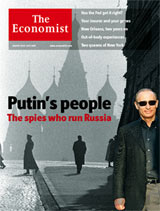Mobile telephony and banking
Phoney finance
Oct 26th 2006 | JOHANNESBURG
From The Economist print edition
Most South Africans do not have bank accounts. But most do have mobile phones
LIFE is now easier for Andile Mbatha, who owns a hair salon in Soweto. Gone are his days of trekking to his bank, which could take two hours by minibus, to send money to relatives. Nor does he keep piles of cash in his salon any more. Last year, he opened a bank account with Wizzit, an innovative provider of financial services. He now sends money to his sister in Cape Town whenever he wants, from wherever he wants, using a simple menu on his mobile phone. Half his customers no longer pay cash for their haircuts. They use their phones to move money from their accounts to his, in a few seconds. “This has taken out a lot of stress,” says Mr Mbatha.
About half a million South Africans now use their mobile phones as a bank. Besides sending money to relatives and paying for goods, they can check balances, buy mobile airtime and settle utility bills. Traditional banks offer mobile banking as an added service to existing customers, most of whom are quite well off. But Wizzit, and to some extent First National Bank (FNB) and MTN Banking (a joint venture between Standard Bank and a mobile-phone network), are chasing another market: the 16m South Africans, over half of the adult population, with no bank account. Significantly, 30% of these people do have mobile phones. Wizzit hired and trained over 2,000 unemployed people, known as Wizzkids, to drum up business. It worked: eight out of ten Wizzit customers previously had no bank account and had never used an ATM.
Mobile banking is just one example of a wider phenomenon in South Africa. With its odd mix of advanced capitalism and developing-world economics, the country is successfully luring people who hitherto dealt only in cash or barter to the world of formal finance. A simplified kind of account called Mzansi was launched in 2004 to reach the unbanked, and portable banks and ATMs have been rolled out in townships and in the countryside. To this fast-changing scene, mobile-phone banking looks to be a promising addition. Millions of South Africans send money to their relatives in other parts of the country. And most of these sums, which add up to about 12 billion rand ($1.5 billion) each year, still move informally.
South Africa is not the first place to use mobile-phone banking: countries such as Japan, South Korea and the Philippines have had it for a while. But the potential is probably bigger in the developing world, and in countries in which migrants remit money to their families in relatively poor homelands. In Greece, a European Union member that is now awash with migrant labour, Albanians or Bulgarians often send money home by putting crumpled banknotes in the hands of a trusted compatriot, who takes a cut. If they could do it all by pressing buttons, they would.
In most of Africa, meanwhile, only a fraction of people have bank accounts—but there is huge demand for cheap and convenient ways to send money and buy prepaid services such as airtime. Many Africans, having skipped landlines and jumped to mobiles, already use prepaid airtime as a way of transferring money.
They could now leap from a world of cash to cellular banking. In Kenya, a pilot scheme called M-Pesa is being used to disburse and pay micro-loans by phone. Meanwhile Celpay, which FNB bought last year from Celtel, a mobile-phone company, is offering platforms for banks and phone companies in Zambia and Congo. In countries like Somalia, with chaotic conditions at home and a huge diaspora, cash transfers by phone would be a boon.
For banks, persuading people not to use branches for simple transactions such as balance enquiries or transfers should reduce operating costs. So far, they charge the same for mobile as for traditional banking, though Wizzit says its services are at least a third cheaper than those of a traditional bank.
But drawing the unbanked into the joys of cell-finance isn't always easy. Many think banking too expensive and complicated, and helping new customers become financially literate takes time. The technology remains clunky in some cases, with downloads requiring dozens of text messages. Several rival platforms are still in the fight, but so far those that emphasise simplicity and ease-of-use over state-of-the-art technology and security have made the greatest strides. A lot also hangs on putting in place the right laws and regulations. They need to be tight enough to protect vulnerable users and discourage money laundering, but open enough to allow innovative mobile banking to grow.
If the transfer of money by mobile phone—between countries as well as within them—takes off, it could have implications far beyond the salons of Soweto. In 2005, according to the United Nations, global migrants remitted $232 billion, of which up to 20% was lost on the way, mostly in bank charges or fraud. If cellular transfers could slash that figure, mobile banking would prove to be a good call.




